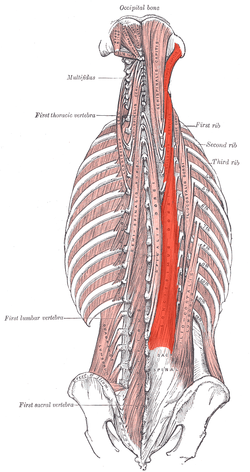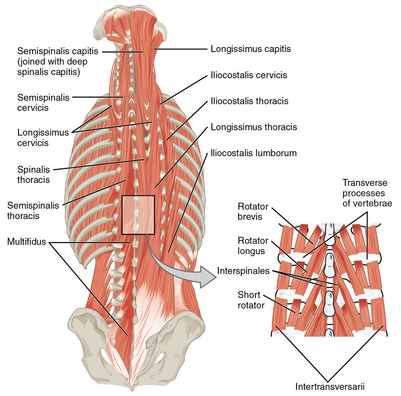Longissimus: Difference between revisions
No edit summary |
(references, citations and links added. Plagiary correction - direct copying from KenHub) |
||
| Line 6: | Line 6: | ||
== Introduction == | == Introduction == | ||
[[File:250px-Longissimus.png|thumb|Longissimus]] | [[File:250px-Longissimus.png|thumb|Longissimus]] | ||
The longissimus muscle is a long intrinsic [[Back Muscles|muscle of the back]] | The longissimus muscle is a long intrinsic [[Back Muscles|muscle of the back]] and together with [[spinalis]] and [[iliocostalis]] muscles, comprises the [[Erector Spinae|erector spinae]] group<ref name=":0">MD GS. Longissimus muscle [Internet]. Kenhub; 2022 [cited 2023 Sept 15]. Available from: https://www.kenhub.com/en/library/anatomy/longissimus-muscle</ref>. Longissimus is the longest and thickest muscle of the erector spinae and lies between spinalis and iliocostalis<ref name=":0" />. Longissimus, together with the rest of the erector spinae group, runs along the entire length of the vertebral column<ref name=":0" />.It is made of three parts listed below<ref name=":0" /><ref>Study.com Longissimus Available:https://study.com/academy/lesson/longissimus-muscle-origin-insertion-function.html (accessed 5.2.2022)</ref>: | ||
#[[Longissimus Capitis|Longissimus capitis]] | #[[Longissimus Capitis|Longissimus capitis]] | ||
# Longissimus cervicis | # Longissimus cervicis | ||
#[[Longissimus Thoracis|Longissimus thoracis]]<ref> | #[[Longissimus Thoracis|Longissimus thoracis]]. | ||
== Anatomy == | |||
[[File:Muscles of the Back.png|thumb|401x401px|Back Muscles]]<u>Origins</u><ref name=":0" />: | |||
* Longissimus capitis: C4-T5 transverse processes | |||
* Longissimus cervicis: T1-T5 transverse processes | |||
* Longissimus thoracis (thoracic part): L1-L5 spinous and transverse processes, sacral posterior surface and posterior iliac crest and median sacral crest | |||
* Longissimus thoracis (lumbar part):Lumbar intermuscular aponeurosis, posterior sacroiliac ligament and medial part of sacropelvic surface of ilium | |||
<u>Insertions</u><ref name=":0" /><u>:</u> | |||
* Longissimus capitis: Mastoid process of temporal bone | |||
* Longissimus cervicis: C2-C6 transverse processes | |||
* Longissimus thoracis (thoracic part): T1-T12 transverse processes and the angles of ribs 7-12 | |||
* Longissimus thoracis (lumbar part): L1-L5 accessory and transverse processes | |||
<u>Action (entire muscle)</u><ref name=":0" /><ref name=":1">1. Longissimus [Internet]. [cited 2023 Sept 15]. Available from: https://teachmeanatomy.info/encyclopaedia/l/longissimus/</ref><u>:</u> | |||
* Extension of the spine when acting bilaterally | |||
* Ipsilateral lateral flexion of the spine when acting unilaterally | |||
<u>Innervation</u><ref name=":0" /><ref name=":1" />: | |||
Lateral branches of posterior rami of spinal nerves. | |||
<u>Blood supply</u><ref name=":0" />: | |||
* Longissimus capitis and cervicis: vertebral artery, transverse cervical artery, deep cervical artery and occipital artery | |||
* Longissimus thoracis: posterior intercostal, subcostal, superior intercostal, lateral sacral and median sacral arteries | |||
Relations | <u>Relations</u> | ||
# Longissimus is found on either sides of the vertebral bodies, running superficial to the transversospinalis and spinalis thoracis muscles. | # Longissimus is found on either sides of the vertebral bodies, running superficial to the transversospinalis and spinalis thoracis muscles. | ||
# Longissimus is located deep to the [[Splenius Capitis|splenius capitis]], [[Splenius Cervicis|splenius colli]], [[Iliocostalis Thoracis|iliocostalis thoracis]], iliocostalis lumborum muscles, and erector spinae [[aponeurosis]]. | # Longissimus is located deep to the [[Splenius Capitis|splenius capitis]], [[Splenius Cervicis|splenius colli]], [[Iliocostalis Thoracis|iliocostalis thoracis]], iliocostalis lumborum muscles, and erector spinae [[aponeurosis]]. | ||
== Physiotherapy == | == Physiotherapy == | ||
[[File:Lower back extension.jpeg|thumb|225x225px|Muscles back, neurodynamic stabilisers]] | [[File:Lower back extension.jpeg|thumb|225x225px|Muscles back, neurodynamic stabilisers]] | ||
Longissimus is a global stabilizer of the back. In their ability to control movement and provide stability, muscles must be seen not as isolated structures, but as part of a chain including ligaments, joints and their capsules, and an intricate neurologic feedback mechanism to coordinate system efficiency. We should take this into consideration when assessing [[Low Back Pain|back pain]]. | |||
== References == | == References == | ||
Latest revision as of 10:29, 15 September 2023
Original Editor - Lucinda hampton
Top Contributors - Lucinda hampton and Wendy Snyders
Introduction[edit | edit source]
The longissimus muscle is a long intrinsic muscle of the back and together with spinalis and iliocostalis muscles, comprises the erector spinae group[1]. Longissimus is the longest and thickest muscle of the erector spinae and lies between spinalis and iliocostalis[1]. Longissimus, together with the rest of the erector spinae group, runs along the entire length of the vertebral column[1].It is made of three parts listed below[1][2]:
- Longissimus capitis
- Longissimus cervicis
- Longissimus thoracis.
Anatomy[edit | edit source]
Origins[1]:
- Longissimus capitis: C4-T5 transverse processes
- Longissimus cervicis: T1-T5 transverse processes
- Longissimus thoracis (thoracic part): L1-L5 spinous and transverse processes, sacral posterior surface and posterior iliac crest and median sacral crest
- Longissimus thoracis (lumbar part):Lumbar intermuscular aponeurosis, posterior sacroiliac ligament and medial part of sacropelvic surface of ilium
Insertions[1]:
- Longissimus capitis: Mastoid process of temporal bone
- Longissimus cervicis: C2-C6 transverse processes
- Longissimus thoracis (thoracic part): T1-T12 transverse processes and the angles of ribs 7-12
- Longissimus thoracis (lumbar part): L1-L5 accessory and transverse processes
- Extension of the spine when acting bilaterally
- Ipsilateral lateral flexion of the spine when acting unilaterally
Lateral branches of posterior rami of spinal nerves.
Blood supply[1]:
- Longissimus capitis and cervicis: vertebral artery, transverse cervical artery, deep cervical artery and occipital artery
- Longissimus thoracis: posterior intercostal, subcostal, superior intercostal, lateral sacral and median sacral arteries
Relations
- Longissimus is found on either sides of the vertebral bodies, running superficial to the transversospinalis and spinalis thoracis muscles.
- Longissimus is located deep to the splenius capitis, splenius colli, iliocostalis thoracis, iliocostalis lumborum muscles, and erector spinae aponeurosis.
Physiotherapy[edit | edit source]
Longissimus is a global stabilizer of the back. In their ability to control movement and provide stability, muscles must be seen not as isolated structures, but as part of a chain including ligaments, joints and their capsules, and an intricate neurologic feedback mechanism to coordinate system efficiency. We should take this into consideration when assessing back pain.
References[edit | edit source]
- ↑ 1.0 1.1 1.2 1.3 1.4 1.5 1.6 1.7 1.8 MD GS. Longissimus muscle [Internet]. Kenhub; 2022 [cited 2023 Sept 15]. Available from: https://www.kenhub.com/en/library/anatomy/longissimus-muscle
- ↑ Study.com Longissimus Available:https://study.com/academy/lesson/longissimus-muscle-origin-insertion-function.html (accessed 5.2.2022)
- ↑ 3.0 3.1 1. Longissimus [Internet]. [cited 2023 Sept 15]. Available from: https://teachmeanatomy.info/encyclopaedia/l/longissimus/









